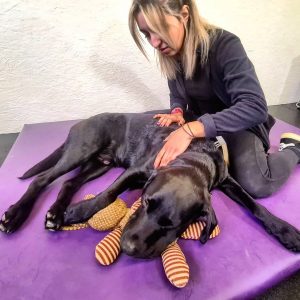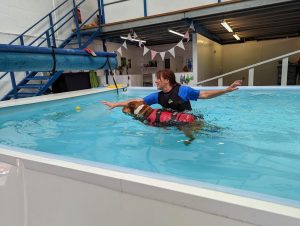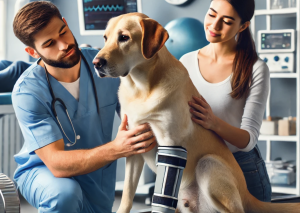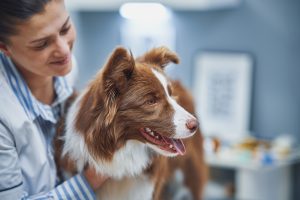Elbow dysplasia is a catch-all term that describes the abnormal development of the elbow. The term includes a number of specific abnormalities, which affect different sites in the joint. If the three bones do not fit together absolutely perfectly the consequence is abnormal concentration of forces on a specific region of the elbow joint causing lameness.
Clinical examination may shows signs such as joint swelling and discomfort on movement of the elbow joint. Diagnosis of elbow dysplasia is important in deciding which treatment option. X-rays are a good starting point but many X-rays are normal. Sometimes a CT scan and/or arthroscopy (camera in the joint) are needed to confirm the problem.
All dogs whether they have surgery or not, should go through a comprehensive physiotherapy program including laser, hydrotherapy, exercise and dietary advice.
There are multiple management options for elbow dysplasia; conservative and surgical however rehabilitation, in either case, can facilitate mobility.
Conservative (non-surgical) Management
If your dog is being treated conservatively many dogs benefit from rehabilitation to protect the elbow joint and prevent further injury or stress to the joint. The cornerstones of non-surgical treatment are body weight management, physiotherapy, exercise modification and medication (anti-inflammatory painkillers).
Post Surgical Rehabilitation
Following surgery it is often of benefit to quickly progress with gentle rehabilitative therapies that prevent soft tissue tightness and maintain mobility. Followed shortly afterwards by careful limb loading exercises. After 2 weeks targeted exercises can begin to further the progression of rehabilitation with ongoing review and programme development with the aim of achieving normal function.

Rehabilitation Options
Water-based Therapy
Hydrotherapy is a perfect environment for a dog with elbow dysplasia. The warm, supportive medium provides pain relief and allows mobilisation of joints in a buoyant / semi-buoyant environment, maintenance and strengthening of specific muscle groups and enhancement of general cardiovascular fitness which on land might not be so easy.
Land-based Therapy
Physiotherapy can help to alleviate the symptoms of elbow dysplasia and enhance your dogs general well being. Physiotherapeutic therapies aim to help reduce pain and swelling, maintain and/or increase joint mobility, and maintain and/or increase muscle mass. Treatment modalities include manual therapies, electrotherapy’s and land-based exercises for strengthening.
Home-based Programmes
A specific home care exercise programme and walking advice will be given to you by your physiotherapist and it will be uniquely designed to suit your dog’s needs. Your physiotherapist will also be able to offer advice on daily living activities such as how best to assist your dog in and out of a car, avoidance of slippery floors, and avoidance of high impact activity such as jumping up or down from furniture, running up and down stairs.
| Time Frame | Aims |
| 0-2 Weeks | Reduce swelling and pain Reduce muscular guarding Maintain soft tissue flexibility Allow limb loading |
| 2-4 Weeks | Progress limb loading Gait re-education Increase muscle mass Maintain soft tissue length & flexibility Management at home |
| 4-6 Weeks | Progress limb loading Gait re-education Increase muscle mass Maintain soft tissue length & flexibility Management at home Develop core stability |
| 6-12 Weeks | Increase exercise tolerance Increase core stability |
| 12+ Weeks | Return to full function Advise on long-term management |














